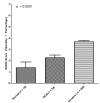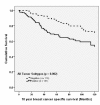The expression of the ubiquitin ligase SIAH2 (seven in absentia homolog 2) is mediated through gene copy number in breast cancer and is associated with a basal-like phenotype and p53 expression
- PMID: 21306611
- PMCID: PMC3109588
- DOI: 10.1186/bcr2828
The expression of the ubiquitin ligase SIAH2 (seven in absentia homolog 2) is mediated through gene copy number in breast cancer and is associated with a basal-like phenotype and p53 expression
Abstract
Introduction: The seven in absentia homolog 2 (SIAH2) protein plays a significant role in the hypoxic response by regulating the abundance of hypoxia-inducible factor-α; however, its role in breast carcinoma is unclear. We investigated the frequency and expression pattern of SIAH2 in two independent cohorts of sporadic breast cancers.
Methods: Immunohistochemical evaluation of SIAH2protein expression was conducted in normal breast tissues and in tissue microarrays comprising ductal carcinoma in situ (DCIS) and a cohort of invasive breast carcinomas. Correlation analysis was performed between SIAH2 and clinicopathological variables and intrinsic breast cancer subgroups and validated in a cohort of 293 invasive ductal carcinomas. Promoter methylation, gene copy number and mRNA expression of SIAH2 were determined in a panel of basal-like tumors and cell lines.
Results: There was a significant increase in nuclear SIAH2 expression from normal breast tissues through to DCIS and progression to invasive cancers. A significant inverse correlation was apparent between SIAH2 and estrogen receptor and progesterone receptor and a positive association with tumor grade, HER2, p53 and an intrinsic basal-like subtype. Logistic regression analysis confirmed the significant positive association between SIAH2 expression and the basal-like phenotype. No SIAH2 promoter methylation was identified, yet there was a significant correlation between SIAH2 mRNA and gene copy number. SIAH2-positive tumors were associated with a shorter relapse-free survival in univariate but not multivariate analysis.
Conclusions: SIAH2 expression is upregulated in basal-like breast cancers via copy number changes and/or transcriptional activation by p53 and is likely to be partly responsible for the enhanced hypoxic drive through abrogation of the prolyl hydroxylases.
Figures




Similar articles
-
Downregulation of SIAH2, an ubiquitin E3 ligase, is associated with resistance to endocrine therapy in breast cancer.Breast Cancer Res Treat. 2009 Jul;116(2):263-71. doi: 10.1007/s10549-008-0125-z. Epub 2008 Jul 16. Breast Cancer Res Treat. 2009. PMID: 18629630
-
The Expression of the Ubiquitin Ligase SIAH2 (Seven In Absentia Homolog 2) Is Increased in Human Lung Cancer.PLoS One. 2015 Nov 18;10(11):e0143376. doi: 10.1371/journal.pone.0143376. eCollection 2015. PLoS One. 2015. PMID: 26580787 Free PMC article.
-
SIAH ubiquitin ligases regulate breast cancer cell migration and invasion independent of the oxygen status.Cell Cycle. 2015;14(23):3734-47. doi: 10.1080/15384101.2015.1104441. Cell Cycle. 2015. PMID: 26654769 Free PMC article.
-
The ubiquitin ligase Siah2 and the hypoxia response.Mol Cancer Res. 2009 Apr;7(4):443-51. doi: 10.1158/1541-7786.MCR-08-0458. Mol Cancer Res. 2009. PMID: 19372575 Free PMC article. Review.
-
The inducible E3 ubiquitin ligases SIAH1 and SIAH2 perform critical roles in breast and prostate cancers.Cytokine Growth Factor Rev. 2015 Aug;26(4):405-13. doi: 10.1016/j.cytogfr.2015.04.002. Epub 2015 May 12. Cytokine Growth Factor Rev. 2015. PMID: 26028498 Review.
Cited by
-
Paradoxical Role for Wild-Type p53 in Driving Therapy Resistance in Melanoma.Mol Cell. 2020 Feb 6;77(3):633-644.e5. doi: 10.1016/j.molcel.2019.11.009. Epub 2019 Dec 11. Mol Cell. 2020. PMID: 31836388 Free PMC article.
-
Role of HDAC3-miRNA-CAGE Network in Anti-Cancer Drug-Resistance.Int J Mol Sci. 2018 Dec 23;20(1):51. doi: 10.3390/ijms20010051. Int J Mol Sci. 2018. PMID: 30583572 Free PMC article. Review.
-
ETS2 and Twist1 promote invasiveness of Helicobacter pylori-infected gastric cancer cells by inducing Siah2.Biochem J. 2016 Jun 1;473(11):1629-40. doi: 10.1042/BCJ20160187. Epub 2016 Apr 5. Biochem J. 2016. PMID: 27048589 Free PMC article.
-
Expression of the preadipocyte marker ZFP423 is dysregulated between well-differentiated and dedifferentiated liposarcoma.BMC Cancer. 2022 Mar 21;22(1):300. doi: 10.1186/s12885-022-09379-6. BMC Cancer. 2022. PMID: 35313831 Free PMC article.
-
miR-335 Targets SIAH2 and Confers Sensitivity to Anti-Cancer Drugs by Increasing the Expression of HDAC3.Mol Cells. 2015 Jun;38(6):562-72. doi: 10.14348/molcells.2015.0051. Epub 2015 May 22. Mol Cells. 2015. PMID: 25997740 Free PMC article.
References
Publication types
MeSH terms
Substances
Grants and funding
LinkOut - more resources
Full Text Sources
Other Literature Sources
Medical
Research Materials
Miscellaneous

